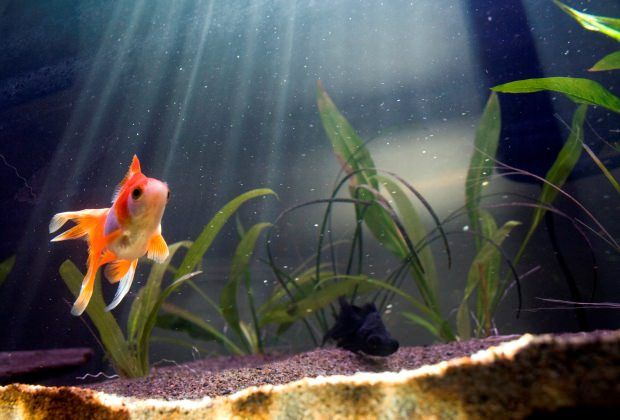
Since The Orients first developed goldfish from carp, these fascinating fish have expanded to include a variety of colors, shapes, and sizes. Some common goldfish types are even bred to develop special characteristics. Bulging eyes, raspberry-like head growths, eyes that gaze heaven-ward, round fluid-filled eye sacks, elaborate nostrils, and flowing fins to name a few.
Goldfish also aren’t just in gold hues. You can find common goldfish types in striking reds, yellows, whites, purples, blues, and blacks – even in calico.
And think that goldfish are just in solid colors? Think again! Common goldfish types are in a mixture of color combinations to fit your personality and tastes.
Few aquarium fish have been developed in as many varieties as the goldfish. It has been estimated that there are over 125 varieties! – Marshall E. Ostrow, author of Goldfish (Barron’s Complete Pet Owner’s Manual)
In fact, there are so many different varieties of goldfish in stores today that it can be difficult to choose which ones to bring home with you. Some common goldfish types, like celestial or bubble-eye goldfish, are even too sensitive for the beginner hobbyist just starting out. Such goldfish are better off with expert care.
Let’s take a look at the most common goldfish types available in pet stores. See any you like?
Slim-bodied Goldfish
Slim-bodied goldfish are so hardy that they are often wonderful choices for the novice goldfish owner. They can even get along well in less-than-ideal water quality and very cool temperatures, but you should still strive to make the water comfortable for your fish. Slim-bodied goldfish are also great for outdoor ponds, since they aren’t as sensitive to cold water as fancy varieties are. What’s more, these goldfish get pretty large and a pond is even recommended.
Since slim-bodied goldfish are strong, fast swimmers and competitive eaters, I don’t suggest keeping these common goldfish types with most fancy varieties. Fancy goldfish are slow-moving and can’t compete for food with slim-bodied goldfish around.
Slim-bodied goldfish are very rambunctious. Because they grow very large and are faster than fancy goldfish, they need at least 30-gallons of water (114 liters) per fish.
 Photo by Tamaki Sono
Photo by Tamaki SonoCommon Goldfish – Some of the hardiest goldfish around, common goldfish get along well in outdoor ponds and can tolerate slightly polluted water better than most common goldfish types (even so, don’t neglect water quality). Common goldfish most resemble their ancestor, the carp, and have a forked caudal (tail) fin with a smooth body. If kept in a pond, common goldfish can grow well over a foot long. These fish are available in many colors, including red, black, orange, white, yellow, and bronze. You can also find them in a combination of colors. Common goldfish are an excellent choice for beginners as long as tank requirements are met.
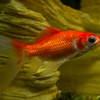 Photo by Sheffield Tiger
Photo by Sheffield TigerComet Goldfish – Like common goldfish, comet goldfish have a slim body with stiff fins. But unlike other common goldfish types, these fish have much longer fins with a deeply forked caudal fin that can be almost as long as the fish’s body. While comet and common goldfish are two different types of goldfish, they’re still usually kept together in the same tank in pet stores (often sold as feeder fish). Like commons, comet goldfish are very hardy and can be kept in ponds (usually) without a problem. They also come in many colors and are excellent beginner goldfish.
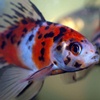 Photo by Michael Gil
Photo by Michael GilShubunkin Goldfish – These fish are also recommended for novice goldfish owners and are recognizable by their beautiful calico pattern (pattern includes orange, yellow, red, brown, black, grey, white, purple, and blue colors). The more blue shubunkin goldfish have, the more valuable they’re considered. Like most slim-bodied goldfish, shubunkins are very hardy, competitive eaters, and fast swimmers.
Egg-shaped Goldfish
Also known as fancy goldfish, egg-shaped goldfish are very sensitive to poor water quality conditions. For this reason, many fancy goldfish are only recommended for experienced fish owners.
Most fancy goldfish have distorted swim bladders (because of their egg-shaped bodies) that can cause problems in poor water conditions – and even cause the fish to swim at a downward angle. Fancy goldfish are not ideal for ponds, since a majority are much too delicate and can’t withstand water temperatures below 60°F (16°F).
As mentioned before, most egg-shaped goldfish shouldn’t be kept with slim-bodied goldfish. If you do keep both goldfish types together, you risk frequent fin nipping, fancy varieties not getting enough to eat, and other problems. Many fancy goldfish also have very delicate features (bubble-eye goldfish, for example) that can easily tear at the slightest nip, making it even more imperative that these goldfish are kept away from fast-moving fish.
Like all common goldfish types, fancy goldfish do just fine if water conditions are met and you take safety precautions when handling or feeding. Fancy goldfish prefer 20 gallons (76 liters) of aquarium water at the very minimum, with 10 gallons (38 liters) for each additional fish.
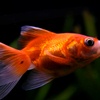 Photo by Annie Roi
Photo by Annie RoiFantail Goldfish – One of the hardiest fancy varieties, fantail goldfish can sometimes even survive fine in ponds or when kept with slim-bodied goldfish (though keep a close eye on your goldfish to make sure they’re getting their share of food). Fantail goldfish are recognizable for their split caudal fin and are typically found in orange or calico colorations, though other colors are also available.
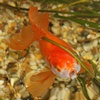 Photo by Jan Smith
Photo by Jan SmithVeiltail Goldfish – While veiltails are thought to be very beautiful and graceful fish, they’re also one of the most sensitive common goldfish types because of their long, flowing fins. They look a lot like fantail goldfish but with slightly rounder bodies and a more distorted swim bladder. Their long fins are very sensitive to goldfish diseases and tears. These fish are not recommended for beginners because they’re so sensitive, and they most certainly shouldn’t be kept in outdoor ponds.
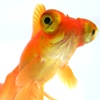 Photo by Louis Hall
Photo by Louis HallTelescope Goldfish – Telescope goldfish have very limited vision because of their protruding eyes (which resemble telescope lenses). The body of a telescope goldfish is very similar to a veiltail goldfish. While telescope goldfish aren’t very hardy, they’re also not as weak as veiltails either. Telescope goldfish come in all sorts of colors. Because of their limited vision, they make poor competitors for food if kept with slim-bodied goldfish. These fish are usually best handled by intermediate goldfish owners.
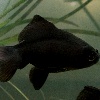 Photo by Katie Brady
Photo by Katie BradyBlack Moor Goldfish – Black moors have a surprisingly high tolerance for cold water temperatures and are very hardy, despite the fact that these jet black fish also have telescope eyes (though the eyes don’t protrude as much as a telescope goldfish). Unlike other common goldfish types, black moors are fine pets for beginners and can even survive well in outdoor ponds.
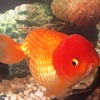 Lionhead Goldfish – Lionhead goldfish aren’t the best swimmers because they lack a dorsal fin (located on the fish’s back). They’re also very slow moving and should only be kept with common goldfish types that are also slow swimmers. Lionhead goldfish are named after the fleshy hood that surrounds their face, except for the eyes, mouth, and nostrils. This hood is soft to the touch but actually doesn’t tear as easily as you may think. Lionheads are sensitive fish and shouldn’t be kept in outdoor ponds with fast-moving goldfish types. They’re also not recommended for beginners.
Lionhead Goldfish – Lionhead goldfish aren’t the best swimmers because they lack a dorsal fin (located on the fish’s back). They’re also very slow moving and should only be kept with common goldfish types that are also slow swimmers. Lionhead goldfish are named after the fleshy hood that surrounds their face, except for the eyes, mouth, and nostrils. This hood is soft to the touch but actually doesn’t tear as easily as you may think. Lionheads are sensitive fish and shouldn’t be kept in outdoor ponds with fast-moving goldfish types. They’re also not recommended for beginners.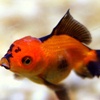 Photo by Lina smiths
Photo by Lina smithsOranda Goldfish – Like lionheads, oranda goldfish have a similar headgrowth (also called the wen), though it only develops on the top of the head and slightly on the sides of the head as well. Oranda goldfish resemble fantails in body shape and are very slow moving. These fish come in a variety of colors and shouldn’t be kept by beginners.
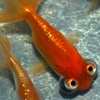 Photo by Michelle Jo
Photo by Michelle JoCelestial Goldfish – Celestial goldfish have limited eyesight, since the eyes are actually locked upwards (almost like the fish is gazing at the sky). For this reason, the Chinese often call celestial goldfish stargazers. Celestial goldfish should only be kept by advanced goldfish hobbyists. They lack a dorsal fin and are slow moving, compared to slim-bodied fish and other common goldfish types. They tend to feel their way around the aquarium or position their body in a way that allows them to see forward.
 Photo by Danny O.
Photo by Danny O.Bubble Eye Goldfish – One of the most fragile common goldfish types around, bubble eye goldfish develop very delicate fluid-filled sacs beneath their eyes. These sacs cause their eyes to slant upward like celestial goldfish (though the upward slant isn’t nearly as severe). Bubble eye goldfish are probably the worse swimmers and can’t handle even the slightest currents, so I wouldn’t recommend a strong power filter for these guys. They spend most of their time resting on the aquarium bottom. When keeping a bubble eye goldfish, it’s important that you only have smooth gravel or no gravel at all. Sharp rocks can easily burst the sacs beneath their eyes and attract goldfish diseases. Like lionhead goldfish, these fish have no dorsal fin. Bubble eye goldfish are only recommended for experts.
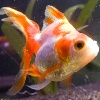 Photo by Katie Brady
Photo by Katie BradyRyukin Goldfish – Ryukin goldfish are good goldfish for beginners and are recognizable by their large hump behind their head that sharply rises at an angle on their back where the dorsal fin is. Ryukin goldfish come in different colors, including orange, white, red, and calico. The most prized ryukins have long, flowing fins.
Goldfish can be fascinating, but the common goldfish types listed above aren’t the only goldfish varieties available. This article only showcases the most commonly found goldfish in aquariums, whether you’re new to fish keeping, you’ve been keeping goldfish for a while, or you’re an expert on goldfish care.
Since there are so many goldfish types available in stores today, it’s impossible not to find at least a few that attract your eye. Even if you think you might have found the perfect goldfish, you should make purchasing decisions wisely and only choose the healthiest fish in the pet store. You should also cycle your aquarium before buying your first goldfish from the pet store to ensure that your aquarium nitrogen cycle (this will make maintaining good water quality easier). Slim-bodied goldfish, fantails, black moors, and ryukins are generally recommended for goldfish owners just starting out.
After you’ve gotten the basic goldfish care requirements down, raising goldfish can be a pleasant and even exciting experience. And once you’ve been keeping goldfish for a while, you can even start looking into exotic goldfish varieties to enhance the beauty of your aquarium – or breed common goldfish types for certain traits to develop your own goldfish varieties.
Which Common Goldfish Types Do You Like Most?
Do you keep goldfish? Have any personal favorites? Suggestions on how to raise common goldfish types? I’d love to hear from you!



13 comments
i have 2 blackmoor golfish in a 28-40l tank. i was wondering how many litres per fish you need?
thx please reply
Hi Rhiannon,
You should try to upgrade to 75 liters when you can. That’s about 20-gallons of water. I wouldn’t recommend any lower for two goldfish. Goldfish excrete tons of waste, and you might have your work cut out for you in a 40 liter tank. Constantly monitor the water with a freshwater aquarium testing kit and stay on top of those water changes. You don’t want to run into any ammonia spikes – those can be fatal.
I never thought there are more kinds of goldfish. I only knew two which are the telescope goldfish and the lionhead goldfish.
Hi James – there are definitely more types of goldfish than the ones listed! Over a hundred breeds according to some sources. That’s a lot of goldfish! But the variety of goldfish available is one of the things that make this hobby so interesting, at least for me. They each have their own personalities and traits! What’s not to love? 🙂
WOW!!! for the first time I knew there were other than the common goldfish and the black moor goldfish… SO cool
Thanks, Thalia! Glad you enjoyed this article. There are actually many more goldfish varieties! They can be very fascinating fish. 🙂
I own two telescope goldfish named Cudi and Kenobi. They have quirky personalities and I swear they know when I am about to feed them and they shake with excitement, and they dig at night.
Cudi and Kenobi sound adorable, Josephine! Goldfish are certainly clever and will often dance with anticipation at the sight of food. If you feed your fish at a specific time per day, they’ll definitely know when to expect munch hour. My goldfish can even recognize the cans of dry food I sometimes feed them in the mornings.
I am wondering what breed my two goldfish are. the one floating around upside down that i have been feeding peas has 4 fins where legs would be. he has a fairly large flowing tail.he also has a fin on his back and one just in front of his tail. he is white with black splotches and orange spots here and there. he has massive, pure black eyes. the other fish is a little smaller, but has the same fins, except it’s tail is much smaller and stiffer. it is white with very shiny scales that shimmer orange and pink. it has red eyes. I am pretty sure they are comets. I haven’t told you their names yet. the bigger one’s called Mr. Mosley and the other ones called Shimmer. when we got them they didn’t have gravel in their tank, they had beads instead. the started pushing the beads around and it looked a bit like they were playing football ( i have seen some fish that were trained to properly play football.). Mr Mosley is very greedy when he is healthy and is a bit of bully.Shimmer is usually quite shy but seems to be sticking up to Mo ever since he ( Mr Mosley) started floating upside down. My Uncle and cousins have a carp, called Goldy which they ADORE. she was origanally ours but we gave her to them. we got her from the pet shop and she was only one square centimetre in size. the lady in the shop said she was a goldfish. anyway, she got bigger and bigger and BIGGER. now she’s with my uncle and she’s the size of my hand. she’s 7 years old and she hasn’t ever gotten sick she’s doing so well because my uncle has well water from underground with almost no chlorine in it. she’s probably going to need a whole pond to herself, because i saw another one of my uncles’s carps and it was the size of my arm
Hi Alannah,
Does the white goldfish with black and orange spots have bulging eyes (like the lens on a telescope)? If so, this goldfish might be a telescope goldfish or a telescope fantail. If the goldfish has a caudal fin (tail fin) that looks like it’s split in two down the middle, each side long and flowing like a veil, you may have a calico fantail (or if the fins are very long, especially the pectoral fins – the part on the body where hands would be – you probably have a calico veiltail).
The smaller goldfish might be a white comet, but if the tail fin is split down the middle, there’s a possibility the second fish is a white fantail.
Mr. Mosley and Shimmer are very cute names. 🙂 I’m so happy they’re getting along with each other!
Yep, some goldfish can grow to be over a foot long! These are mostly comets, commons, and shubunkins. So if you have a comet goldfish, he’ll most likely get a lot bigger if you take good care of him!
Hi Im Annalyn,
Im so glad to see your site about how to give complete care of the fishes. We have three gold fish they are common types of goldfish. One is separated to other aquarium because she is very agressive to other shes always attacking and i dont have any idea just to keep the other stress frêe. Her name is Raffy. And two are Tobby and conny they are together in the aquarium. But Sad to say and Im quite worried of Conny because she did not eat for three days now i have a feeling that shes ill because shes really weak these days, swimming up and down but mostly she stay at the surface. We decided to isolate her to avoid spreading of disease if ever she really have and Tobby is affected. What should i do to save Conny. Please i want to hear your advice. Thank you
Hi Annalyn,
How is water quality? Have you tested the water for ammonia or pH lately? If your goldfish spends a lot of time at the surface, that’s an indicator that there’s something wrong with the water. If you haven’t done so already, I’d definitely recommend getting a freshwater test kit – you can buy them at any local pet store and the liquid version lasts years (I find them to be more accurate than strips). These help you determine common problems with the water, so you can maintain high water quality and help prevent diseases. You can even bring a sample of your aquarium water to the pet store and have them test it for you, though it’s much more handy to have your own test kit. Then you can test the water each week when you do your water change.
Have you changed the water recently? I recommend weekly water changes, changing out 25% of the water each week. This will help keep ammonia levels down and oxygen levels up.
Also, how large is your aquarium? You might be facing an overcrowding problem – this is common with goldfish aquariums. Fancy goldfish enjoy 20 gallons at the very minimum for one or two fish (preferably more). For three fancy goldfish, you’ll want 30-40 gallons of water or two 20-gallon aquariums. Goldfish excrete tons of waste and can quickly face an ammonia problem in an overcrowded tank.
I hope your goldfish starts to feel better! Let me know if the problem gets worse and definitely test the water if you haven’t done so already. In the meantime, you should continue doing 25% water changes every week, or more frequently (2-3 times per week) if your aquarium doesn’t meet the 20-gallon minimum.
Wow hehehe